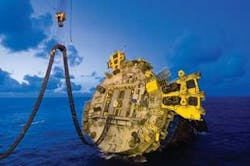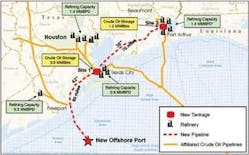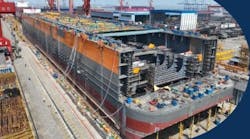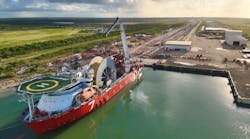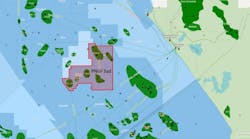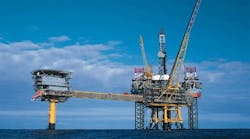David Paganie - Houston
OCS executive ban removed; MMS starts planning
In a move to ease pressures at the gas pump, President Bush has lifted the executive moratorium held on exploration in specific areas of the US outer continental shelf.
“One of the most important steps we can take to expand domestic oil and natural gas production is to increase access to offshore exploration in the OCS,” Bush says.
MMS estimates about 574 million acres of the US OCS are off limits, representing about 85% of OCS acreage offshore the lower 48 states. Estimated resources in the banned areas are 17.8 Bbbl of oil and 76.5 tcf of natural gas (mean estimates), according to MMS.
Bush’s withdrawal does not clear restrictions within existing marine sanctuaries, and areas near Florida are off limits until 2022 under the Gulf of Mexico Energy Security Act of 2006.
Bush’s father enacted the OCS executive withdrawal in June 1990, which expanded the moratorium imposed by Congress in 1982. In 1998, President Clinton extended Bush’s executive order until June 2012. Bush’s move this year clears the executive ban on the restricted areas in the OCS, but Congress must lift its legislative prohibition on those areas before drilling can begin. At print, Congress was in recess and had not passed legislation to clear the ban.
Meanwhile, Secretary of the Interior Dirk Kempthorne has directed MMS to begin developing a new five-year plan that could include OCS areas previously off limits, pending action by Congress.
“This initiative could provide a significant advantage for the incoming administration, offering options it would not otherwise have had until at least 2010,” Kempthorne says. “This action would provide a two-year head start for the next administration on developing a new five-year program.”
The development process starts with a call for information from all parties on what a new five-year program should consider.
The current program runs from 2007-2012 and includes 21 lease sales in eight of the 26 OCS planning areas in the Gulf of Mexico, Alaska, and the Atlantic. It does not include areas under a congressional ban, with the exception of Virginia. The new program, depending on public comment, can consider any area, although any leasing in a banned area would need congressional action.
Sale 207 attracts $487.3 million in high bids
The Western GoM Oil and Gas Lease Sale 207 attracted $487,297,676 in high bids, according to MMS. Fifty-three companies submitted 423 bids on 319 tracts comprising over 1.8 million acres offshore Texas. The sum of all bids received totaled $607,134,968.
Approximately 74% of the tracts receiving bids are in greater than 800 m (2,625 ft) of water, 17% are in ultra deepwater (more than 1,600 m [5,249 ft]). The deepest tract bid on is Alaminos Canyon block 783 in 2,977 m (9,767 ft) of water. The highest bid received on a tract was $61,110,000, submitted by Statoil Gulf of Mexico LLC for Alaminos Canyon block 380. ExxonMobil submitted the highest total of high bids – 130, followed by Hess, with 22. ExxonMobil also bid the highest sum of high bids – $127.3 million.
null
ATP secures rigs for 2008, 2009
ATP Oil & Gas has secured four drilling rigs for the balance of this year and 2009. The rigs are Seadrill AmericasWest Sirius, Hercules Rig 211, Ensco 72, and Diamond Ocean Victory.
West Sirius is on the Telemark Hub project. The rig is drilling and running casing on the upper sections of two wells at Mirage (Mississippi Canyon block 941) and, if time permits, take a third well to completion at Morgus (Mississippi Canyon block 942).
The bottom section of the remaining wells will be drilled and completed with the Nabors202 platform rig, to be installed on the ATP MinDOC I, a floating drilling and production facility that will be moored at Mirage/Morgus early in 2009.
ATP also entered into a letter of intent for the semisubmersible DiamondOcean Victory to drill and run casing in four wells at Telemark (Atwater Valley block 63) beginning in mid-2009. Similar to the operation at Mirage/Morgus, after the pre-drilling is complete, ATP will move on location its second MinDOC, the MinDOC II. The Nabors 202 platform rig will then be transferred to the MinDOC II where it will be used to finalize drilling and complete the four wells.
Ocean Victory is scheduled to sidetrack and complete one well and complete a second well on the Clipper field (Green Canyon block 299 and 300) during the first half of 2009.
The DiamondOcean Confidence is scheduled to arrive in 2Q 2009. During a 150-day period, ATP expects to sidetrack/drill and complete two development wells, one at King’s Peak (Mississippi Canyon block 217) and one at Aconcagua (Mississippi Canyon block 305). After completing these two wells the vessel will depart for another job and return after approximately one year to sidetrack/drill and complete two additional wells, one each at Aconcagua and De Soto Canyon block 133.
After installation of a tripod platform, the Hercules jackup211 was scheduled to be on location at West Cameron block 462 during August 2008. It was scheduled to complete two previously drilled wells and prepare them for production in the third quarter of this year.
“We now have secured rigs for our entire 2008 scheduled drilling program and for all but one well of our 2009 drilling program,” says George Morris, ATP’s COO.
Meanwhile, ATP’s bids for Atwater Valley block 19 and block 62 have been accepted for award by MMS. Block 19 is in approximately 4,199 ft (1,280 m) of water and block 62 is in approximately 4,173 ft (1,272 m) of water, and both are contiguous to the Telemark Hub. ATP acquired a 100% working interest in both blocks for a total cost of $463,980 and will serve as operator of each block.
Deepwater contracts
Chevron has awarded a pre-FEED study to INTEC Engineering for the Big Foot project in Walker Ridge block 29 in 5,000 ft (1,524 m) of water. The study is scheduled to be complete in the fourth quarter of this year.
The conceptual engineering work is to identify development alternatives and covers all subsea systems including evaluation of subsea boosting options.
Also in the Walker Ridge area, Petrobras America has selected BMT Scientific Marine Services (BMT) as the systems integrator for a comprehensive integrity monitoring system for the Cascade Chinook free-standing hybrid riser (FSHR) and disconnectable turret buoy.
The FSHR integrity monitoring system’s main role is to monitor the stabilizing uplift forces on five riser towers. It will also record riser, turret buoy, and FPSO position, motion and mooring data, and will continue to operate even when the FPSO disconnects and leaves the field.
BMT will partner with Chemtech, who will provide software packages, and Sonardyne, who will supply acoustic positioning and communications equipment for the project.
Thunder Horse expected onstream by year-end
The Thunder Horse project is expected to be onstream by the end of the year, according to BP. Commissioning of the field’s semisubmersible floating production unit is under way with early production from the first well in Thunder Horse South, the company says.
Additional wells from Thunder Horse South will be brought on stream through the end of the year, with Thunder Horse North scheduled to start up in the second half of 2009.
In other deepwater news, Chevron says mooring of theBlind Faith semisubmersible is complete and commissioning is under way. First production is expected in the second half of this year.
Chevron also reports that installation of theTahiti spar’s hull is complete and work on the associated flowlines, risers, and topsides are near complete, with first oil expected in 3Q 2009.
Helix Energy Solutions says first production from the Phoenix field has been pushed back due to delay of the conversion of the anchor platform -Helix Producer I. Conversion of HPI is expected to be completed during 2Q 2009 for first production in July.
JV to build Texas offshore oil port
Enterprise Products Partners and Oiltanking Holding Americas have formed a joint venture to design, construct, own, and operate a new Texas offshore oil port and pipeline system to facilitate delivery to refining centers along the upper Texas Gulf Coast.
The Texas Offshore Port System (TOPS) project will include an offshore port, two onshore storage facilities with approximately 5.1 MMbbl of total oil storage capacity, and an associated 160-mi (257-km) pipeline system with capacity to deliver up to 1.8 MMb/d of oil. System capacity could be expanded with the construction of additional offshore facilities, the companies say. Development of the offshore port system and onshore infrastructure is supported by long-term contracts with Motiva Enterprises and an affiliate of Exxon Mobil Corp., which together have committed a total volume of approximately 725,000 b/d.
TOPS is designed to allow operations 24 hours per day without restrictions on movements and vessel size that limit most ship channels. TOPS would be able to accommodate the largest vessels that can carry approximately 3 MMbbl of oil. The location of TOPS is also designed to avoid delays and risks related to fog, navigation hazards, and channel closures on coastal waterways.
The project involves the construction of a deepwater port approximately 36 mi (58 km) offshore Freeport, Texas, and an onshore distribution and storage system. As designed, the deepwater port will feature two single-point mooring buoys that will essentially serve as floating docks for the vessels. Located in about 115 ft (35 m) of water, the buoys will be able to offload oil at rates up to 100,000 barrels per hour.
A subsea pipeline will connect the buoys to the onshore distribution system near Freeport. Using directional drilling techniques to minimize beach impact, the TOPS pipeline system will run from the offshore port shore crossing to Freeport and extend along the Texas Gulf Coast to Texas City, Texas, connecting to a 3.9-MMbbl oil storage facility. From there, the pipeline would connect to existing crude oil pipeline systems currently serving the Texas City and Houston Ship Channel refineries.
A separate but complementary component of TOPS would involve construction of a 75-mi (56-km) pipeline extending from Texas City to its terminus at a planned storage facility with 1.2 MMbbl of crude oil capacity near Port Arthur, Texas. The storage tanks are designed to connect to various refineries and other facilities via pipelines. This pipeline system would have the added capability of delivering waterborne and offshore oil from existing Texas City docks and storage facilities to all Port Arthur/Beaumont area refineries.


